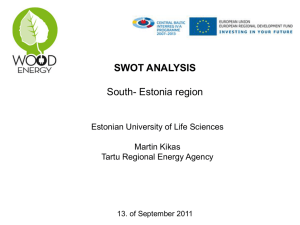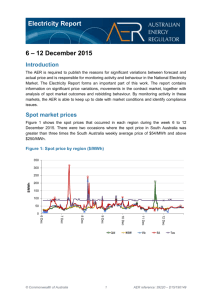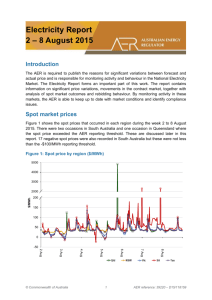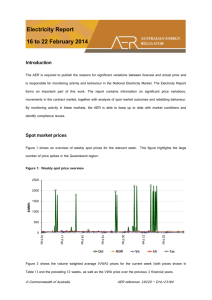3B Newbery Revised - Electricity Policy Research Group
advertisement
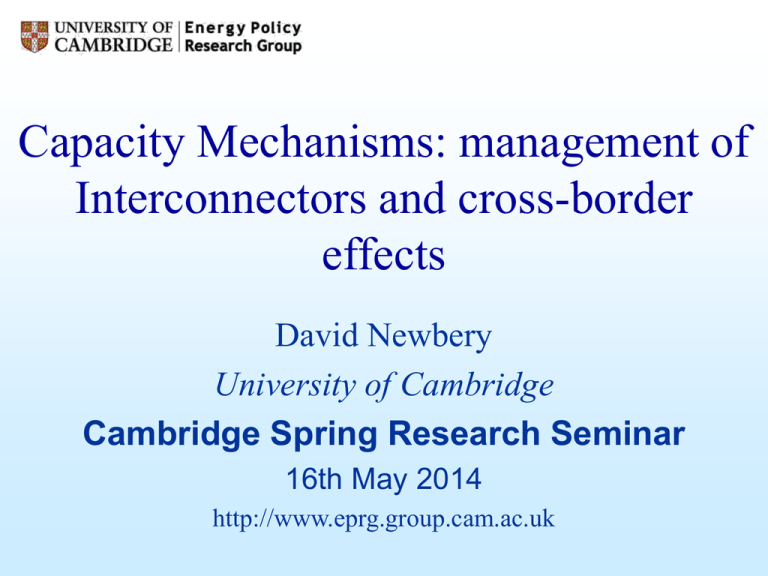
Capacity Mechanisms: management of Interconnectors and cross-border effects David Newbery University of Cambridge Cambridge Spring Research Seminar 16th May 2014 http://www.eprg.group.cam.ac.uk Outline • What is the problem? • Energy-only markets and capacity payments: theory – policy failures, price caps • Proposed EMR capacity auction – defended by missing money (VOLL > max energy price) – complications: risk, market coupling rules • Interconnectors: problems Energy Policy Research Group D Newbery 2 What is the problem? Ofgem’s derated capacity margin System Operator’s problem Source: DECC IA First Capacity Auction delivery Interconnectors by 2018 IFA Britned Moyle EWIC NEMO Eclink Total to France to NL to NI to RoI to Belgium to France 2 GW 1 GW 0.5 GW (or 0.25?) 0.5 GW 1 GW 1 GW 6 GW • potential swing 12 GW = 20% peak demand • emergency SO actions cannot reverse IC flow Key question - what contributon to derated capacity? Poyry (2012): 50-80% depending on margins abroad Energy Policy Research Group D Newbery 4 Energy-only markets • If generators can (and are allowed to) bid scarcity prices no problem? – France (de facto monopoly) bids high peak prices – GB has adequate capacity and flat prices • Wind, PV, cheap coal, low C prices drive clean spark spreads negative (in DE especially) – electricity prices affected by policy => policy uncertainty undermines peaking investments needed Capacity contracts to address policy failure Energy Policy Research Group D Newbery 5 France much peakier than GB European power exchanges 2012 € 100 € 1,000 € 900 € 800 € 700 € 600 € 500 € 400 € 300 € 200 € 100 €0 0.0% € 90 € 80 Euros/MWh € 70 0.5% 1.0% 1.5% 2.0% € 60 € 50 France UK MIP (Euros) Germany 2012 Netherlands € 40 € 30 € 20 € 10 €0 0% 10% 20% 30% 40% 50% 60% percent time price higher than 70% 80% 90% 100% Capacity payments: theory Efficient price = SMC + CP SMC = system marginal cost, CP = capacity payment CP = LoLP*(VoLL - SMC) LoLP = Loss of Load Probability in each hour LOLE = LoLP over year (Loss of Load Expectation) set at 3 hrs in GB => VoLL = Value of Lost Load = £17,000/MWh • Max price in Euphemia day-ahead = €3,000/MWh – Max price in France = €3,000/MWh – Max price in SEM (Ireland) = €1,000/MWh Newbery 2014 7 Experience in the Pool and BETTA • The Pool (1990-2001) had an explicit CP at LoLP*(VoLL-SMP), VoLL = £(2013)5,000/MWh – (but SMP is as bid, not SMC) • NETA/BETTA was an energy-only market with a Balancing Mechanism, System Buy and Sell prices – reformed many times, long side defaults to prompt price – initially pay-as-bid, then average of last N MW – consulting on Significant Code Review to deal with 2015/16 How well did they signal scarcity? Energy Policy Research Group D Newbery 8 Pool prices were peakier than spot market as they had a capacity payment UK price duration curves 2012 and Pool Purchase price 1998-9 Price duration £100 £400 £350 UKRPD Cal 2012 N2EX 2011-12 APX 2011-12 PPP 1998-9 at RPI £/MWh £80 £300 £250 £200 £150 £100 £50 £(2012)/MWh £60 £0 0.0% 0.5% 1.0% 1.5% percentage price higher than £40 £20 £0 0% 10% 20% 30% 40% 50% 60% -£20 percentage price higher than 70% 80% 90% 100% 2.0% CP in the Pool - 50% revenue in 1.8% (158) hours PPP-SMP 1998-9 at 2012 RPI prices £100 100% £80 80% £(2012) /MWh £300 £60 60% £250 £200 £150 £40 40% £100 £50 £0 £20 0.00% 0.50% 1.00% 1.50% £0 2.00% 20% 0% 0% 5% 10% capacity payment 15% percent total capacity revenue 20% Pool prices 1998-9 and System Buy Price 2008 Price duration curves Pool 1998-99 and Balancing 2008 at 2013 CPI prices £800 £200 £700 £600 £500 £400 £150 £300 PPP £(2013)/MWh £200 £100 £0 0% £100 1% 2% 3% 4% 5% Balancing prices peakier than Pool £50 £0 0% 10% 20% 30% 40% 50% 60% 70% percent price higher than PPP PPP-SMP System Buy Price 2008 80% 90% 100% Imbalance prices not adequately marginal? Price duration of System Buy Price 2013-4 £100 £350 £300 £250 £200 £80 £150 £100 £50 £0 £60 1% 1% 2% 2% 3% 3% £/MWh 0% £40 £20 £0 0% 10% 20% 30% 40% 50% 60% Percent time price higher than 70% 80% 90% 100% GB Balancing Market • Ofgem conducts Significant Code Review of BM • Proposes: – single marginal price – load shedding bids at proxy Value of Lost Load • pVOLL = £3,000 rising to £6,000/MWh by 2018 • DECC sets VOLL at £17,000/MWh – STOR bids in at f(pVOLL,LoLP) BM price has never hit even £3,000/MWh Missing money: 3hrs*(£17,000-6,000)/MWh Energy Policy Research Group D Newbery 13 Capacity to be replaced Seems small - can it be covered by interconnectors? Source: DECC IA GB Capacity Auction • Pay-as-clear descending clock auction in 2014 for delivery 2018/19 – max energy price assumed £6/kWh – LOLE = 3 hrs => VOLL = £17/kWh – => missing money = 3 hrs*(17-6)/kWh = £33/kW • new build gets 15 yr contract at auction price – existing plant: 1 yr contract unless major refurbish • must be price taker unless good cause, entrants set price • existing plant can delay until later auction (2017) • DSR auctioned from 2016: 1 yr contracts Energy Policy Research Group D Newbery 15 Illustrative auction demand curve £75/kW year New plant sets high price for all No new plant and price is low Source: DECC IA Initially adverse Net benefit is difference between large producer surplus and large consumer loss GB coupled to NWE 4/2/14 SEM not until 2016 SWE coupled to NWE 13/5/14 Issues with interconnectors • Interconnectors increase security of supply – provided they are free to respond to scarcity => they should have a positive derated capacity – Poyry estimates 50-80% • Efficient pricing benefits trading country – if partner mis-prices they lose => efficient pricing drives out inefficient pricing • But Euphemia imposes €3,000/MWh cap Energy Policy Research Group D Newbery 19 Cross-border capacity procurement • EU wants any capacity market to be EU-wide • What contract can deliver capacity from abroad? – How does specific foreign plant guarantee to export to GB in stress hours? • PTR defaults to FTR on the day, but GB price may not signal true scarcity (and there is a price cap) – Would it not likely do so anyway without a CP? • Why not have a contract with the SO for imports over the interconnector in stress hours? – Devolve to SO securing supply – or SO auctions for capacity over IC? Energy Policy Research Group D Newbery 20 Investment in interconnectors • The economics of investment look good anyway – and get better with more wind, PV, carbon price floor • recognising contribution to security increases value – DC interconnectors are controllable – GB Interconnectors are logical suppliers of capacity • problem: TO’s cannot contract for generation – but SO (abroad) could run auction for capacity and access => rent collected by ICs EU open access to CP needs firm access to ICs and penalties for non-delivery Energy Policy Research Group D Newbery 21 Conclusions • Theory of scarcity pricing clear – leads to CP = LoLP*(VoLL-SMC) – energy-only markets could do this in theory • and hedge with reliability options • main failures: policy uncertainty and price caps – and lack of credible distant futures markets • Capacity markets can address these – but potentially large transfers from consumers And need much higher Euphemia price cap Energy Policy Research Group D Newbery 22 Appendix Capacity Mechanisms: management of Interconnectors and cross-border effects David Newbery University of Cambridge Cambridge Spring Research Seminar 16th May 2014 http://www.eprg.group.cam.ac.uk Acronyms BM Balancing mechanism (or market) CONE Cost of new entry (net = net of revenue from selling power) CP, CM Capacity payment, capacity market DSR demand side response EMR (UK) Electricity Market Reform F(P)TR Financial (physical) transmission right IC Interconnector LOLE Loss of load expectation = LoLP over year LoLP Loss of Load probability PV Photo voltaic SEM Single Electricity Market for Ireland SMC(P) System marginal cost (price) SO system operator SRMC short-run marginal cost STOR short-term operating reserve TEM Target Electricity Market TO transmission owner VOLL Value of Lost Load (£17,000/MWh in GB) Energy Plicy Research Group D Newbery 24 References • DECC (2102) Electricity Market Reform – Capacity Market Impact Assessment at https://www.gov.uk/government/uploads/system/uploads/attach ment_data/file/252743/Capacity_Market_Impact_Assessment_ Oct_2013.pdf •Poyry (2012) Poyry (2012) Impact Of EMR On Interconnection: A report to DECC at https://www.gov.uk/government/uploads/system/uploads/attach ment_data/file/252744/Poyry_Report_on_Impact_of_CM_on_ Interconnection.pd? 1 Capacity payments in Irish SEM • Bidding Code of Practice requires generation to bid into Pool at SRMC => missing money => CP based on VoLL & LoLP • generators get ex post system MC (SMC) + CP • VoLL scaled to deliver adequate payment for new entry, paid part on ex ante LoLP, part on ex post – stabilises revenue, reduces volatility • paid on imports, charged to exports ex post pricing incompatible with TEM Energy Policy Research Group D Newbery 26 SEM Capacity Payments 2012 and 2013 € 50 100% 50% revenue in 12% hours € 200 80% € 100 € 30 60% € 50 €0 0.0% € 20 0.2% 2012 € 10 0.4% 2013 0.6% 0.8% 1.0% 40% percent of total cap pay 20% €0 % time 95% 90% 85% 80% 75% 70% 65% 60% 55% 50% 45% 40% 35% 30% 25% 20% 15% 10% 5% 0% 0% Euros/MWh € 150 Average €7/MWh percent of total capacity payment € 40 € 250 Benefits of market integration for EU 27+2 relative to base case 18 16 Billion Euros/year 14 Optimal TX, shared reserves, not balancing 2015 Only half optimal TX built 12 10 8 2020 2030 Remarkably little extra compared to integration No shared reserves 6 4 2 0 Integrated low TX self-secure shared balancing DSR Scenario Base case: each country matches average production to consumption arbitrages over coupled IC’s, no shared balancing or reserves Source: DG ENER (2013) 28









